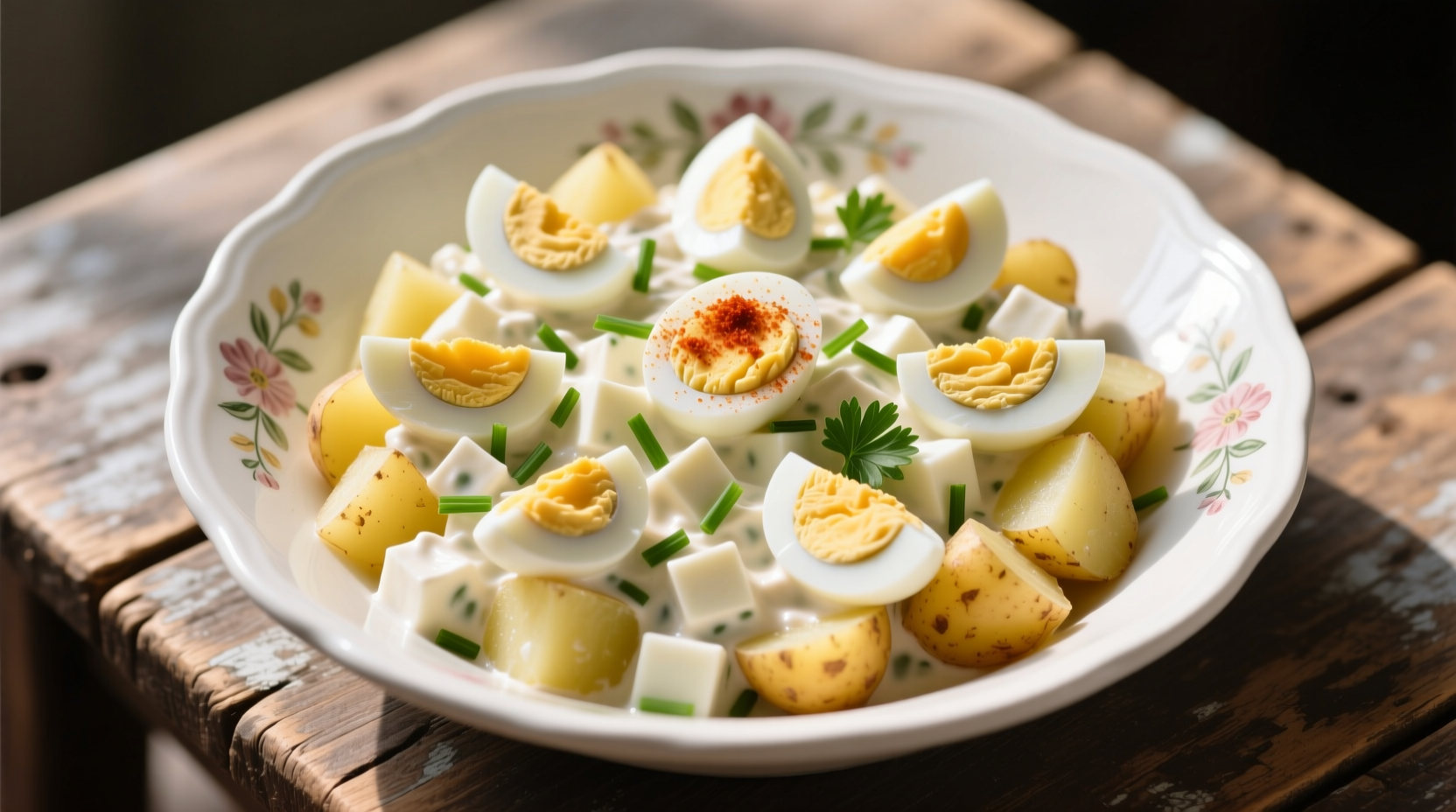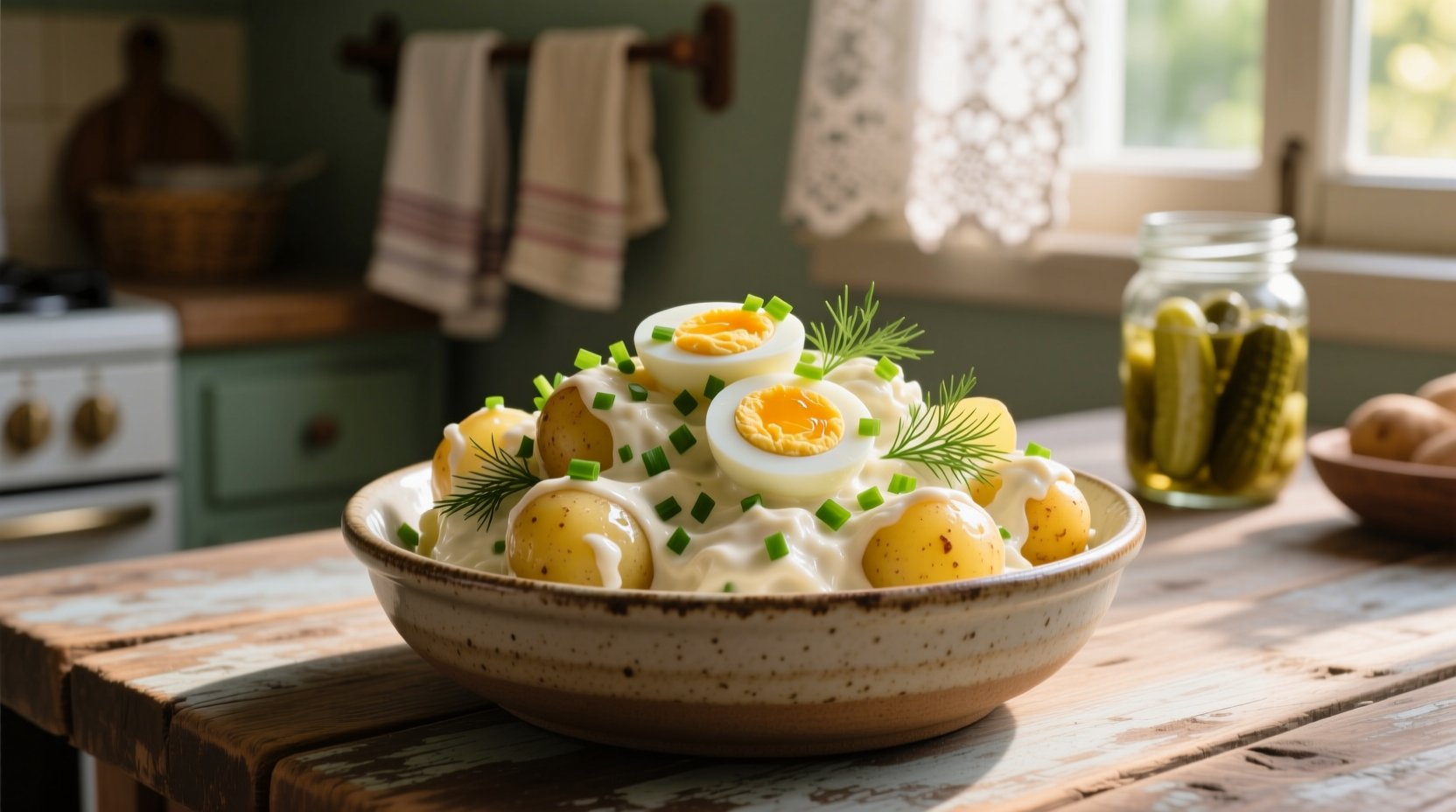Nothing says summer gathering quite like a classic potato salad with eggs. This beloved side dish combines tender potatoes, perfectly cooked eggs, and a creamy dressing that creates a satisfying texture contrast in every bite. Our tested recipe delivers consistent results with professional chef techniques adapted for home kitchens.
The Essential Potato Selection Guide
Choosing the right potato variety makes or breaks your potato salad. Waxy potatoes maintain their shape better during cooking and dressing application, while starchy varieties can become mushy. According to the USDA Agricultural Research Service, the starch content directly impacts texture retention in prepared dishes.
| Potato Variety | Starch Content | Best For Potato Salad? | Flavor Profile |
|---|---|---|---|
| Yukon Gold | Medium | ★★★★☆ | Buttery, rich |
| Red Bliss | Low | ★★★★★ | Mild, earthy |
| Russet | High | ★☆☆☆☆ | Earthy, robust |
| Fingerling | Low-Medium | ★★★☆☆ | Nutty, complex |
For optimal results, we recommend using a combination of Red Bliss and Yukon Gold potatoes. The Red Bliss maintains firmness while the Yukon Gold adds creaminess to the final texture. Always cut potatoes to uniform 3/4-inch cubes before cooking to ensure even tenderness.
Mastering the Egg Component

Eggs serve multiple functions in potato salad: they add protein, create visual appeal with their yellow centers, and contribute to the dressing's emulsification. The key to perfect hard-boiled eggs for potato salad lies in precise timing and cooling.
Follow this professional chef timeline for flawless eggs:
- 0-8 minutes: Place eggs in cold water, bring to gentle boil
- 9-12 minutes: Maintain gentle simmer (not rolling boil)
- 13 minutes: Immediately transfer to ice water bath
- 20 minutes: Cool completely before peeling
- 30 minutes: Chop to desired size (1/4-inch pieces work best)
According to food safety guidelines from the FDA, eggs should reach an internal temperature of 160°F (71°C) to be safely consumed, which occurs at the 12-minute mark in gently simmering water. Never skip the ice bath step, as it stops the cooking process and makes peeling significantly easier.
Building Flavor Layers in Your Dressing
The dressing makes or breaks potato salad. Our tested formula balances creaminess with brightness:
- 1 cup high-quality mayonnaise (not salad dressing)
- 2 tablespoons yellow mustard (for tang)
- 1 tablespoon apple cider vinegar (for brightness)
- 1 teaspoon celery seed (essential flavor enhancer)
- Salt and freshly ground pepper to taste
Mix dressing ingredients first before combining with potatoes. Add dressing to slightly warm potatoes (not hot) to allow absorption without breaking the emulsion. This technique, recommended by the Culinary Institute of America, creates superior flavor integration compared to dressing cold potatoes.
Avoiding Common Potato Salad Mistakes
Even experienced cooks make these critical errors that compromise texture and flavor:
- Overcooking potatoes: Results in mushy texture that falls apart when mixed
- Adding dressing to hot potatoes: Causes mayonnaise to separate and become greasy
- Using undercooked eggs: Creates rubbery whites and unset yolks
- Skipping the resting period: Prevents flavors from properly melding
Potato salad with eggs performs best when prepared 4-6 hours before serving. This resting period allows flavors to develop fully while giving potatoes time to absorb the dressing without becoming soggy. For optimal results, store covered in the refrigerator with plastic wrap pressed directly against the surface to prevent discoloration.
Variations for Different Occasions
While the classic version shines at most gatherings, these adaptations suit specific contexts:
- Lighter version: Substitute half the mayonnaise with Greek yogurt (best for weekday lunches)
- German-style: Use vinegar-based dressing without mayonnaise (ideal for hot weather)
- Southwestern twist: Add diced jalapeños and cilantro (perfect for taco nights)
- Herb-infused: Incorporate fresh dill, chives, and parsley (elevates holiday meals)
Consider your serving context when choosing variations. Picnics in hot weather demand more vinegar-based dressings for food safety, while holiday gatherings benefit from the richer traditional version. The University of Minnesota Extension notes that mayonnaise-based salads should not remain unrefrigerated for more than two hours, especially in temperatures above 90°F.
Serving and Storage Recommendations
For best presentation, serve potato salad with eggs in a chilled bowl with fresh herb garnish. It pairs exceptionally well with grilled meats, sandwiches, and as part of a picnic spread. Leftovers keep well in airtight containers in the refrigerator for 3-4 days.
When making ahead, prepare components separately and combine 4-6 hours before serving. Store potatoes and dressing separately if preparing more than 12 hours in advance. This approach maintains optimal texture and prevents the potatoes from becoming waterlogged.
How many eggs per pound of potatoes makes the best potato salad?
The ideal ratio is 3 large eggs per pound of potatoes. This provides sufficient egg presence without overwhelming the potato flavor. Professional chefs consistently use this proportion for balanced texture and visual appeal.
Can I make potato salad with eggs ahead of time?
Yes, potato salad actually improves when made 4-6 hours in advance. The flavors meld together during refrigeration. For best results, prepare no more than 24 hours ahead, as extended storage causes potatoes to absorb too much dressing and become soggy.
Why does my potato salad become watery after refrigeration?
Watery potato salad typically results from dressing potatoes while they're too hot, causing the mayonnaise to break. Another common cause is using high-moisture potato varieties like Russets. Always cool potatoes slightly (not completely cold) before adding dressing, and choose waxy potato varieties for better moisture control.
What's the secret to preventing green rings around egg yolks?
Green rings form when eggs are overcooked, causing a reaction between iron in the yolk and sulfur in the white. Prevent this by limiting boiling time to 12 minutes maximum, followed immediately by an ice bath. The FDA recommends this precise timing to achieve fully cooked yet visually appealing eggs.











 浙公网安备
33010002000092号
浙公网安备
33010002000092号 浙B2-20120091-4
浙B2-20120091-4